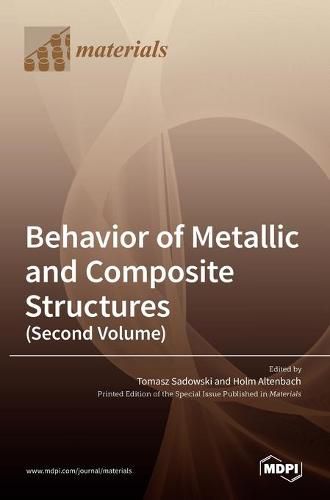Readings Newsletter
Become a Readings Member to make your shopping experience even easier.
Sign in or sign up for free!
You’re not far away from qualifying for FREE standard shipping within Australia
You’ve qualified for FREE standard shipping within Australia
The cart is loading…






This title is printed to order. This book may have been self-published. If so, we cannot guarantee the quality of the content. In the main most books will have gone through the editing process however some may not. We therefore suggest that you be aware of this before ordering this book. If in doubt check either the author or publisher’s details as we are unable to accept any returns unless they are faulty. Please contact us if you have any questions.
Various types of metallic and composite structures are used in modern engineering practice. For aerospace, car industry, and civil engineering applications, the most important are thin-walled structures made of dierent types of metallic alloys, brous composites, laminates, and multifunctional materials with a more complicated geometry of reinforcement including nanoparticles or nanobres. The current applications in modern engineering require analysis of structures of various properties, shapes, and sizes (e.g., aircra
wings) including structural hybrid joints, subjected to dierent types of loadings, including quasi-static, dynamic, cyclic, thermal, impact, penetration, etc. The advanced metallic and composite structures should satisfy multiple structural functions during operating conditions. Structural functions include mechanical properties such as strength, stiness, damage resistance, fracture toughness, and damping. Non-structural functions include electrical and thermal conductivities, sensing, actuation, energy harvesting, self-healing capability, electromagnetic shielding, etc. The aim of this SI is to understand the basic principles of damage growth and fracture
processes in advanced metallic and composite structures that also include structural joints. Presently, it is widely recognized that important macroscopic properties, such as macroscopic stiness and strength, are governed by processes that occur at one to several scales below the level of observation. A thorough understanding of how these processes influence the reduction of stiffness and strength forms the key to the design of improved innovative structural elements and the analysis of existing ones.
$9.00 standard shipping within Australia
FREE standard shipping within Australia for orders over $100.00
Express & International shipping calculated at checkout
This title is printed to order. This book may have been self-published. If so, we cannot guarantee the quality of the content. In the main most books will have gone through the editing process however some may not. We therefore suggest that you be aware of this before ordering this book. If in doubt check either the author or publisher’s details as we are unable to accept any returns unless they are faulty. Please contact us if you have any questions.
Various types of metallic and composite structures are used in modern engineering practice. For aerospace, car industry, and civil engineering applications, the most important are thin-walled structures made of dierent types of metallic alloys, brous composites, laminates, and multifunctional materials with a more complicated geometry of reinforcement including nanoparticles or nanobres. The current applications in modern engineering require analysis of structures of various properties, shapes, and sizes (e.g., aircra
wings) including structural hybrid joints, subjected to dierent types of loadings, including quasi-static, dynamic, cyclic, thermal, impact, penetration, etc. The advanced metallic and composite structures should satisfy multiple structural functions during operating conditions. Structural functions include mechanical properties such as strength, stiness, damage resistance, fracture toughness, and damping. Non-structural functions include electrical and thermal conductivities, sensing, actuation, energy harvesting, self-healing capability, electromagnetic shielding, etc. The aim of this SI is to understand the basic principles of damage growth and fracture
processes in advanced metallic and composite structures that also include structural joints. Presently, it is widely recognized that important macroscopic properties, such as macroscopic stiness and strength, are governed by processes that occur at one to several scales below the level of observation. A thorough understanding of how these processes influence the reduction of stiffness and strength forms the key to the design of improved innovative structural elements and the analysis of existing ones.